PM2.5 Estimation and Spatial-Temporal Pattern Analysis Based on the Modified Support Vector Regression Model and the 1 km Resolution MAIAC AOD in Hubei, China
Abstract
:1. Introduction
2. Materials and Methodology
2.1. Study Area
2.2. Experimental Data
2.2.1. MAIAC and MODIS AOD Data
2.2.2. Auxiliary Variables
- Meteorological data
- Land cover data
2.2.3. Ground PM2.5 Measurements
2.2.4. Data Pre-Processing and Integration
2.2.5. Model Constructing and Training
2.3. Principle of SVR
2.4. Basi Idea of MSVR
3. Experiments and Results
3.1. MSVR Model Construction and PM2.5 Estimations
3.1.1. Statistical Features of the Variables
3.1.2. Estimated PM2.5 by MSVR
3.2. Pattern Analysis of PM2.5 Concentrations
3.2.1. Spatial Pattern of the Estimated PM2.5
3.2.2. Seasonal Pattern of the Estimated PM2.5
4. Discussion
4.1. Performance of the MSVR Model
4.2. Advantages of MAIAC AOD
4.3. Analyses of the Spatiotemporal Pattern of PM2.5
4.4. Limitations
5. Conclusions
Author Contributions
Funding
Acknowledgments
Conflicts of Interest
References
- Landrigan, P.J.; Fuller, R.; Acosta, N.J.R.; Adeyi, O.; Arnold, R.; Basu, N.; Baldé, A.B.; Bertollini, R.; Bose-O’Reilly, S.; Boufford, J.I.; et al. The Lancet Commission on pollution and health. Lancet 2018, 391, 462–512. [Google Scholar] [CrossRef] [Green Version]
- Beelen, R.; Raaschou-Nielsen, O.; Stafoggia, M.; Andersen, Z.J.; Weinmayr, G.; Hoffmann, B.; Wolf, K.; Samoli, E.; Fischer, P.; Nieuwenhuijsen, M.J.; et al. Effects of long-term exposure to air pollution on natural-cause mortality: An analysis of 22 European cohorts within the multicentre ESCAPE project. Lancet 2014, 383, 785–795. [Google Scholar] [CrossRef]
- Polezer, G.; Tadano, Y.S.; Siqueira, H.V.; Godoi, A.F.; Yamamoto, C.I.; De André, P.A.; Pauliquevis, T.; Andrade, M.D.F.; Oliveira, A.; Saldiva, P.H.; et al. Assessing the impact of PM2.5 on respiratory disease using artificial neural networks. Environ. Pollut. 2018, 235, 394–403. [Google Scholar] [CrossRef] [PubMed]
- Chan, Y.C.; Simpson, R.W.; Mctainsh, G.H.; Vowles, P.D.; Cohen, D.D. Characterisation of chemical species in PM2.5 and PM10 aerosols in Brisbane, Australia. Atmos. Environ. 2015, 37, 31–39. [Google Scholar] [CrossRef]
- Wang, Y.; Jia, C.; Tao, H.; Zhang, L.; Liang, X.; Ma, J.-M.; Gao, H.; Huang, T.; Zhang, K. Chemical characterization and source apportionment of PM2.5 in a semi-arid and petrochemical-industrialized city, Northwest China. Sci. Total Environ. 2016, 573, 1031–1040. [Google Scholar] [CrossRef] [PubMed]
- Ma, Z.; Hu, X.; Sayer, A.M.; Levy, R.; Zhang, Q.; Xue, Y.; Tong, S.; Bi, J.; Huang, L.; Liu, Y. Satellite-based spatiotem-poral trends in PM2. 5 concentrations: China. Environ. Health Perspect. 2016, 124, 184–192. [Google Scholar] [CrossRef] [PubMed] [Green Version]
- Li, S.; Joseph, E.; Min, Q. Remote sensing of ground-level PM2.5 combining AOD and backscattering profile. Remote Sens. Environ. 2016, 183, 120–128. [Google Scholar] [CrossRef]
- Paciorek, C.J.; Yang, L. AOD–PM2.5 Association: Paciorek and Liu Respond. Environ. Health Perspect. 2010, 118, A110–A111. [Google Scholar] [CrossRef] [Green Version]
- Zhang, T.; Gong, W.; Wang, W.; Ji, Y.; Zhu, Z.; Huang, Y. Ground Level PM2.5 Estimates over China Using Satellite-Based Geographically Weighted Regression (GWR) Models Are Improved by Including NOâ‚‚ and Enhanced Vegetation Index (EVI). Int. J. Environ. Res. Public Health 2016, 13, 1215. [Google Scholar] [CrossRef]
- Wei, J.; Huang, W.; Li, Z.; Xue, W.; Peng, Y.; Sun, L.; Cribb, M. Estimating 1-km-resolution PM2.5 concentrations across China using the space-time random forest approach. Remote Sens. Environ. 2019, 231, 111221. [Google Scholar] [CrossRef]
- Xia, X.; Qi, Q.; Liang, H.; Zhang, A.; Jiang, L.; Ye, Y.; Liu, C.; Huang, Y. Pattern of spatial distribution and tem-poral variation of atmospheric pollutants during 2013 in Shenzhen, China. ISPRS Int. J. Geoinf. 2017, 6, 2. [Google Scholar] [CrossRef]
- Gross, B.; Schäfer, K.; Keckhut, P. Special Section Guest Editorial: Advances in Remote Sensing for Air Quality Management. J. Appl. Remote Sens. 2018, 12, 042601. [Google Scholar] [CrossRef] [Green Version]
- Park, S.; Choi, J. Satellite-measured atmospheric aerosol content in Korea: Anthropogenic signals from decadal records. GISci. Remote Sens. 2016, 53, 1–17. [Google Scholar] [CrossRef]
- Yuanyu, X.; Yuxuan, W.; Kai, Z.; Wenhao, D.; Baolei, L.; Yuqi, B. Daily Estimation of Ground-Level PM2.5 Concentrations over Beijing Using 3 km Resolution MODIS AOD. Environ. Sci. Technol. 2015, 49, 12280–12288. [Google Scholar]
- You, W.; Zang, Z.; Zhang, L.; Li, Y.; Wang, W. Estimating national-scale ground-level PM25 concentration in China using geographically weighted regression based on MODIS and MISR AOD. Environ. Sci. Pollut. Res. 2016, 23, 8327–8338. [Google Scholar] [CrossRef]
- You, W.; Zang, Z.; Pan, X.; Zhang, L.; Chen, D. Estimating PM2.5 in Xi’an, China using aerosol optical depth: A comparison between the MODIS and MISR retrieval models. Sci. Total. Environ. 2015, 505, 1156–1165. [Google Scholar] [CrossRef]
- Zang, L.; Mao, F.; Guo, J.; Gong, W.; Wang, W.; Pan, Z. Estimating hourly PM1 concentrations from Himawari-8 aerosol optical depth in China. Environ. Pollut. 2018, 241, 654–663. [Google Scholar] [CrossRef]
- Yumimoto, K.; Nagao, T.M.; Kikuchi, M.; Sekiyama, T.T.; Murakami, H.; Tanaka, T.Y.; Ogi, A.; Irie, H.; Khatri, P.; Okumura, H. Aerosol data assimilation using data from Himawari-8, a next-generation geostationary meteorological satellite: Aero-sol assimilation with Himawari-8. Geophys. Res. Lett. 2016, 43, 5886–5894. [Google Scholar] [CrossRef]
- Yao, F.; Si, M.; Li, W.; Wu, J. A multidimensional comparison between MODIS and VIIRS AOD in estimating ground-level PM2.5 concentrations over a heavily polluted region in China. Sci. Total Environ. 2018, 618, 819–828. [Google Scholar] [CrossRef]
- Mhawish, A.; Banerjee, T.; Sorek-Hamer, M.; Lyapustin, A.; Broday, D.M.; Chatfield, R. Comparison and evaluation of MODIS Multi-angle Implementation of Atmospheric Correction (MAIAC) aerosol product over South Asia. Remote Sens. Environ. 2019, 224, 12–28. [Google Scholar] [CrossRef]
- Lyapustin, A.; Wang, Y.; Korkin, S.; Huang, D. MODIS Collection 6 MAIAC algorithm. Atmos. Meas. Tech. 2018, 11, 5741–5765. [Google Scholar] [CrossRef] [Green Version]
- Boyouk, N.; Léon, J.-F.; Delbarre, H.; Podvin, T.; DeRoo, C. Impact of the mixing boundary layer on the relationship between PM2.5 and aerosol optical thickness. Atmos. Environ. 2010, 44, 271–277. [Google Scholar] [CrossRef]
- Zheng, C.; Zhao, C.; Zhu, Y.; Wang, Y.; Shi, X.; Wu, X.; Chen, T.; Wu, F.; Qiu, Y. Analysis of influential factors for the relationship between PM2.5 and AOD in Beijing. Atmos. Chem. Phys. Discuss. 2017, 17, 13473–13489. [Google Scholar] [CrossRef] [Green Version]
- Ma, Z.; Hu, X.; Huang, L.; Bi, J.; Liu, Y. Estimating Ground-Level PM2.5 in China Using Satellite Remote Sensing. Environ. Sci. Technol. 2014, 48, 7436–7444. [Google Scholar] [CrossRef] [PubMed]
- Guo, J.; Xia, F.; Zhang, Y.; Liu, H.; Li, J.; Lou, M.; He, J.; Yan, Y.; Wang, F.; Min, M.; et al. Impact of diurnal variability and meteorological factors on the PM2.5—AOD relationship: Implications for PM2.5 remote sensing. Environ. Pollut. 2017, 221, 94–104. [Google Scholar] [CrossRef] [Green Version]
- Liu, Y.; Paciorek, C.J.; Koutrakis, P. Estimating Regional Spatial and Temporal Variability of PM 2.5 Concentrations Using Satellite Data, Meteorology, and Land Use Information. Environ. Health Perspect. 2009, 117, 886–892. [Google Scholar] [CrossRef] [Green Version]
- Xiao, L.; Lang, Y.; Christakos, G.J.A.E. High-resolution spatiotemporal mapping of PM2. 5 concentrations at Mainland Chi-na using a combined BME-GWR technique. Atmos. Environ. 2018, 173, 295–305. [Google Scholar] [CrossRef]
- Zhai, L.; Li, S.; Zou, B.; Sang, H.; Fang, X.; Xu, S. An improved geographically weighted regression model for PM 2.5 concentration estimation in large areas. Atmos. Environ. 2018, 181, 145–154. [Google Scholar] [CrossRef]
- Su, T.; Li, J.; Li, C.; Lau, A.K.-H.; Yang, D.; Shen, C. An intercomparison of AOD-converted PM2.5 concentrations using different approaches for estimating aerosol vertical distribution. Atmos. Environ. 2017, 166, 531–542. [Google Scholar] [CrossRef]
- Chen, G.; Li, S.; Knibbs, L.D.; Hamm, N.; Cao, W.; Li, T.; Guo, J.; Ren, H.; Abramson, M.J.; Guo, Y. A machine learning method to estimate PM2.5 concentrations across China with remote sensing, meteorological and land use information. Sci. Total Environ. 2018, 636, 52–60. [Google Scholar] [CrossRef]
- Yang, Q.; Yuan, Q.; Yue, L.; Li, T.; Shen, H.; Zhang, L. The relationships between PM2.5 and aerosol optical depth (AOD) in mainland China: About and behind the spatio-temporal variations. Environ. Pollut. 2019, 248, 526–535. [Google Scholar] [CrossRef] [PubMed]
- Yang, W.; Deng, M.; Xu, F.; Wang, H. Prediction of hourly PM2.5 using a space-time support vector regression model. Atmos. Environ. 2018, 181, 12–19. [Google Scholar] [CrossRef]
- Roy, A.; Chakraborty, S. Support vector regression based metamodel by sequential adaptive sampling for reliability analysis of structures. Reliab. Eng. Syst. Saf. 2020, 200, 106948. [Google Scholar] [CrossRef]
- Zhang, T.; Zhu, Z.; Gong, W.; Zhu, Z.; Sun, K.; Wang, L.; Huang, Y.; Mao, F.; Shen, H.; Li, Z.; et al. Estimation of ultrahigh resolution PM2.5 concentrations in urban areas using 160 m Gaofen-1 AOD retrievals. Remote Sens. Environ. 2018, 216, 91–104. [Google Scholar] [CrossRef]
- Giles, D.M.; Sinyuk, A.; Sorokin, M.G.; Schafer, J.S.; Smirnov, A.; Slutsker, I.; Eck, T.F.; Holben, B.N.; Lewis, J.R.; Campbell, J.R. Advancements in the Aerosol Robotic Network (AERONET) Version 3 database–automated near-real-time quality control algorithm with improved cloud screening for Sun photometer aerosol optical depth (AOD) measurements. Atmos. Meas. Tech. 2019, 12, 169–209. [Google Scholar] [CrossRef] [Green Version]
- Zhang, Z.; Wu, W.; Fan, M.; Wei, J.; Tan, Y.; Wang, Q. Evaluation of MAIAC aerosol retrievals over China. Atmos. Environ. 2019, 202, 8–16. [Google Scholar] [CrossRef]
- Chen, G.; Knibbs, L.D.; Zhang, W.; Li, S.; Cao, W.; Guo, J.; Ren, H.; Wang, B.; Wang, H.; Williams, G. Estimating spatiotem-poral distribution of PM1 concentrations in China with satellite remote sensing, meteorology, and land use information. Environ. Pollut. 2018, 233, 1086–1094. [Google Scholar] [CrossRef]
- Wang, J.; Ogawa, S. Effects of Meteorological Conditions on PM2.5 Concentrations in Nagasaki, Japan. Int. J. Environ. Res. Public Health 2015, 12, 9089–9101. [Google Scholar] [CrossRef]
- Huang, F.; Xia, L.; Chao, W.; Qin, X.; Wei, W.; Luo, Y.; Tao, L.; Qi, G.; Jin, G.; Chen, S.; et al. PM2.5 Spatiotemporal Variations and the Relationship with Meteorological Factors during 2013-2014 in Beijing, China. PLoS ONE 2015, 10, e0141642. [Google Scholar] [CrossRef]
- Trifonova, T.A.; Mishchenko, N.V.; Grishina, Y.P. A remote sensing-based method for determining industrial air pollution. Mapp. Sci. Remote Sens. 1998, 35, 22–30. [Google Scholar] [CrossRef]
- Chen, B.; Li, S.; Yang, X.; Lu, S.; Wang, B.; Niu, X. Characteristics of atmospheric PM2.5 in stands and non-forest cover sites across urban-rural areas in Beijing, China. Urban Ecosyst. 2016, 19, 867–883. [Google Scholar] [CrossRef]
- Kumar, A. Long term (2003–2012) spatiotemporal MODIS (Terra/Aqua level 3) derived climatic variations of aerosol opti-cal depth and cloud properties over a semiarid urban tropical region of Northern India. Atmos. Environ. 2014, 83, 291–300. [Google Scholar] [CrossRef]
- Hao, Y.; Liu, Y. The influential factors of urban PM2.5 concentrations in China: A spatial econometric analysis. J. Clean. Prod. 2016, 112, 1443–1453. [Google Scholar] [CrossRef]
- Kelly, K.M.; Dennis, M.L. Transforming between WGS84 Realizations and other Reference Frames. In AGU Fall Meeting Abstracts; American Geophysical Union: Washington, DC, USA, 2018. [Google Scholar]
- Noble, W. What is a support vector machine? Nat. Biotechnol. 2006, 24, 1565–1567. [Google Scholar] [CrossRef] [PubMed]
- Smola, A.J.; Schölkopf, B. A tutorial on support vector regression. Stat. Comput. 2004, 14, 199–222. [Google Scholar] [CrossRef] [Green Version]
- Chang, C.-C.; Lin, C.-J. LIBSVM: A library for support vector machines. ACM Trans. Intell. Syst. Technol. 2011, 2, 27. [Google Scholar] [CrossRef]
- Zhu, S.; Lian, X.; Wei, L.; Che, J.; Shen, X.; Yang, L.; Qiu, X.; Liu, X.; Gao, W.; Ren, X.; et al. PM2.5 forecasting using SVR with PSOGSA algorithm based on CEEMD, GRNN and GCA considering meteorological factors. Atmos. Environ. 2018, 183, 20–32. [Google Scholar] [CrossRef]
- Awad, M.; Khanna, R. Support vector regression. In Efficient Learning Machines; Apress: Berkeley, CA, USA, 2015; pp. 67–80. [Google Scholar]
- Wang, S.; Zhou, C.; Wang, Z.; Feng, K.; Hubacek, K. The characteristics and drivers of fine particulate matter (PM2.5) distribution in China. J. Clean. Prod. 2017, 142, 1800–1809. [Google Scholar] [CrossRef]
- Balasundaram, S. On Lagrangian support vector regression. Expert Syst. Appl. 2010, 37, 8784–8792. [Google Scholar] [CrossRef]
- Chudnovsky, A.; Tang, C.; Lyapustin, A.; Wang, Y.; Schwartz, J.; Koutrakis, P.J.A.C. A critical assessment of high-resolution aerosol optical depth retrievals for fine particulate matter predictions. Atmos. Chem. Phys. 2013, 13, 10907. [Google Scholar] [CrossRef] [Green Version]
- Chudnovsky, A.A.; Koutrakis, P.; Kloog, I.; Melly, S.J.; Nordio, F.; Lyapustin, A.I.; Wang, Y.; Schwartz, J. Fine particulate matter predictions using high resolution Aerosol Optical Depth (AOD) retrievals. Atmos. Environ. 2014, 89, 189–198. [Google Scholar] [CrossRef] [Green Version]
- Chudnovsky, A.A.; Kostinski, A.; Lyapustin, A.; Koutrakis, P.J.E.P. Spatial scales of pollution from variable resolution satellite imaging. Environ. Pollut. 2013, 172, 131–138. [Google Scholar] [CrossRef] [PubMed]
- Guan, D.; Su, X.; Zhang, Q.; Peters, G.P.; Liu, Z.; Lei, Y.; He, K. The socioeconomic drivers of China’s primary PM 2.5 emissions. Environ. Res. Lett. 2014, 9, 024010. [Google Scholar] [CrossRef] [Green Version]
- Huang, T.; Yu, Y.; Wei, Y.; Wang, H.; Huang, W.; Chen, X. Spatial–seasonal characteristics and critical impact factors of PM2. 5 concentration in the Beijing–Tianjin–Hebei urban agglomeration. PLoS ONE 2018, 13, e0201364. [Google Scholar]
- Cheng, Z.; Li, L.; Liu, J. Identifying the spatial effects and driving factors of urban PM2.5 pollution in China. Ecol. Indic. 2017, 82, 61–75. [Google Scholar] [CrossRef]
- Lin, C.; Labzovskii, L.; Mak, H.W.L.; Fung, J.C.; Lau, A.K.; Kenea, S.T.; Bilal, M.; Hey, J.D.V.; Lu, X.; Ma, J. Observation of PM2.5 using a combination of satellite remote sensing and low-cost sensor network in Siberian urban areas with limited reference monitoring. Atmos. Environ. 2020, 227, 117410. [Google Scholar] [CrossRef]
- Toth, T.D.; Zhang, J.; Campbell, J.R.; Hyer, E.; Reid, J.S.; Shi, Y.; Westphal, D.L. Impact of data quality and surface-to-column representativeness on the PM2.5/satellite AOD relationship for the contiguous United States. Atmos. Chem. Phys. Discuss. 2014, 14, 6049–6062. [Google Scholar] [CrossRef] [Green Version]
- Zang, Z.; Wang, W.; You, W.; Li, Y.; Ye, F.; Wang, C. Estimating ground-level PM2.5 concentrations in Beijing, China using aerosol optical depth and parameters of the temperature inversion layer. Sci. Total. Environ. 2017, 575, 1219–1227. [Google Scholar] [CrossRef]
- Lalitaporn, P.; Kurata, G.; Matsuoka, Y.; Thongboonchoo, N.; Surapipith, V.J. Long-term analysis of no 2, co, and aod seasonal variability using satellite observations over asia and intercomparison with emission inventories and model. Atmos. Health 2013, 6, 655–672. [Google Scholar] [CrossRef]
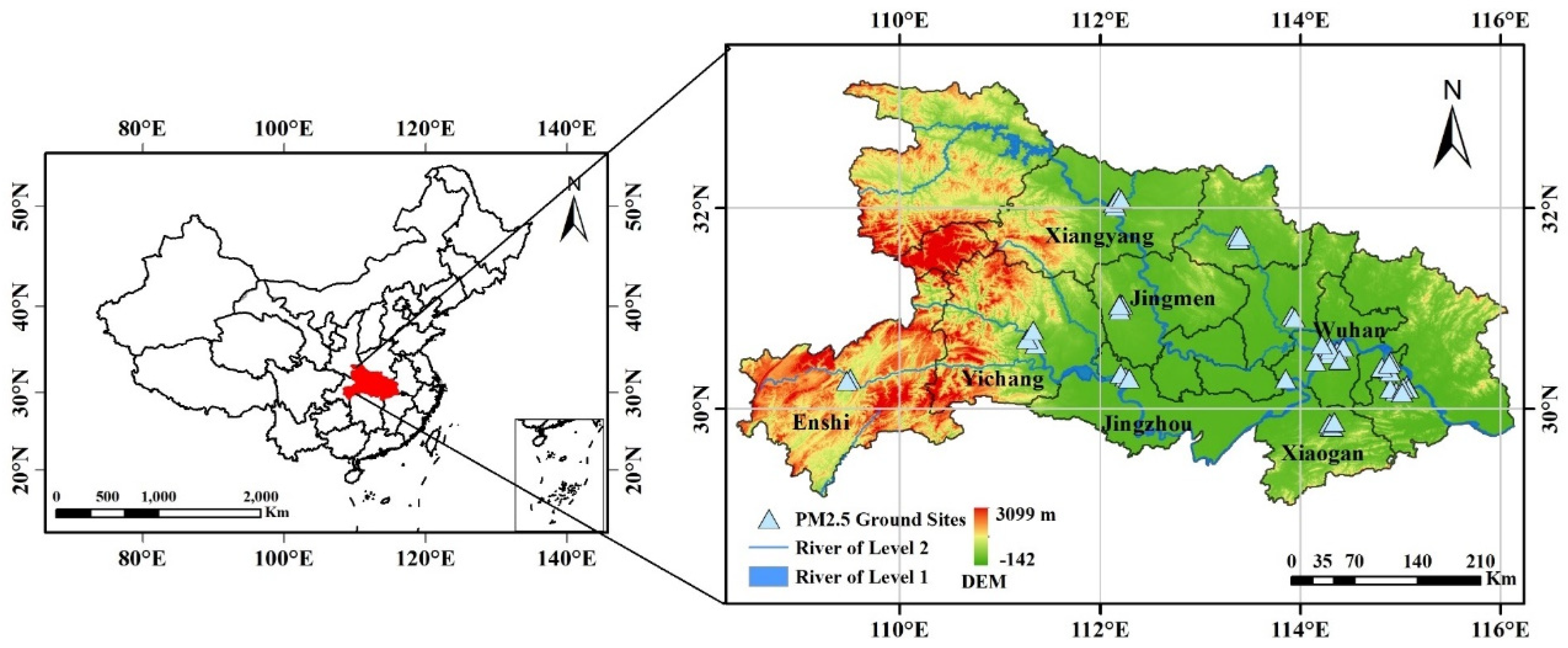
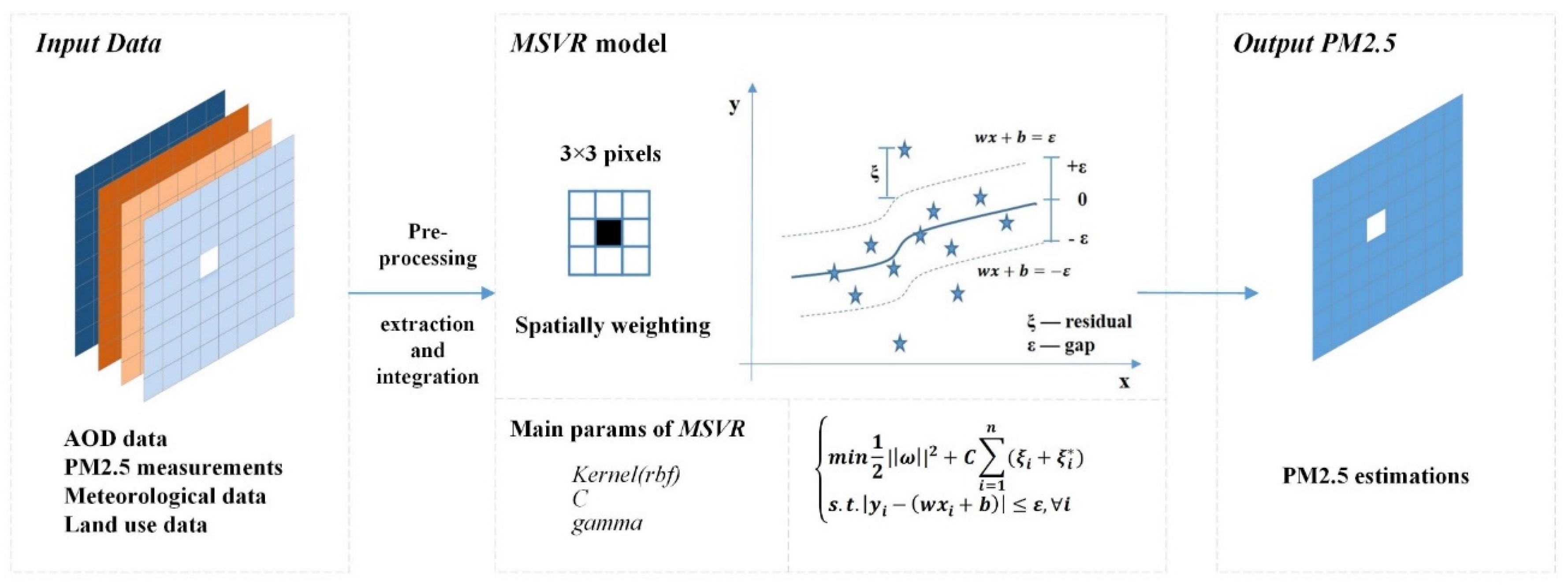
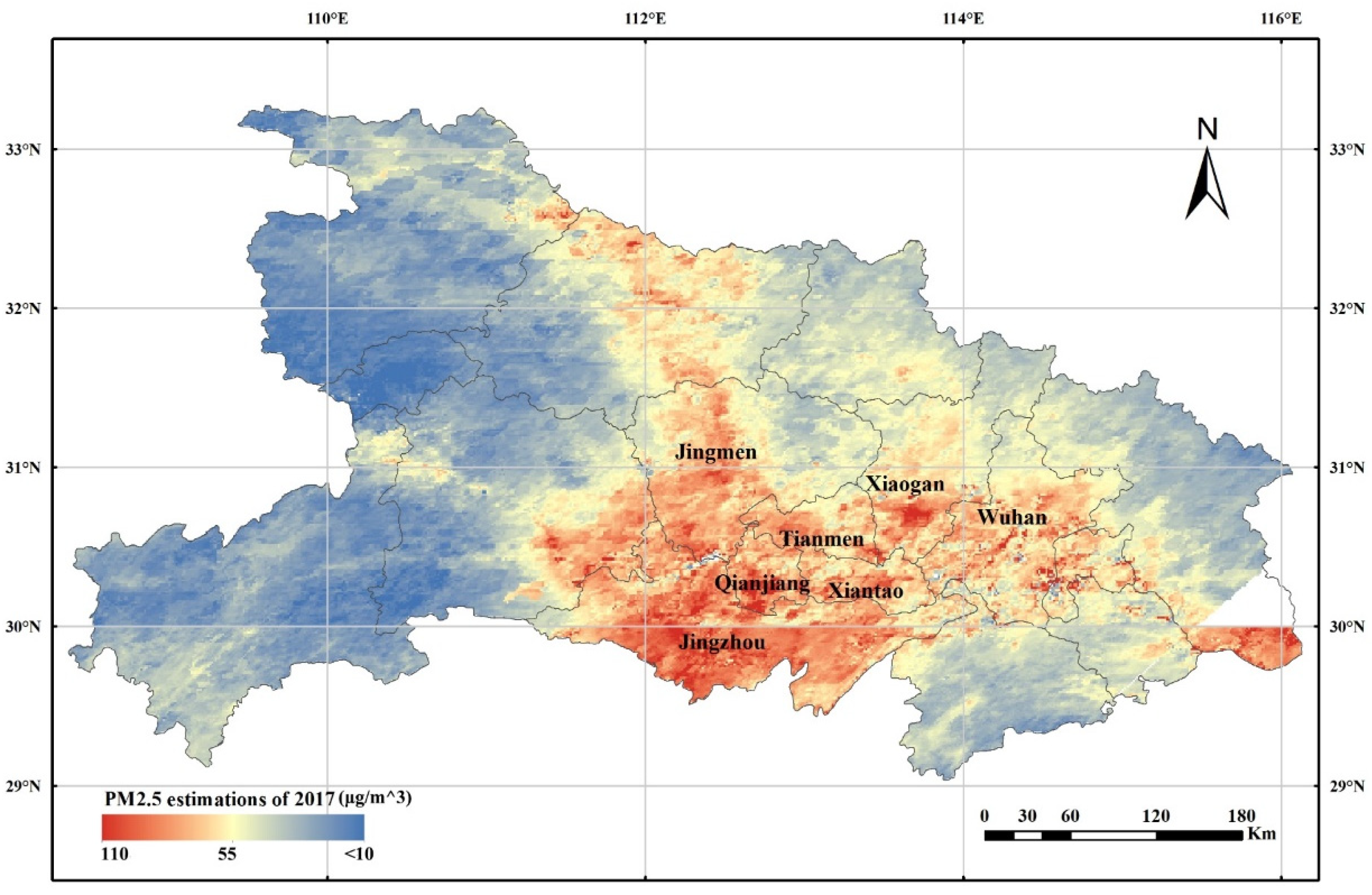

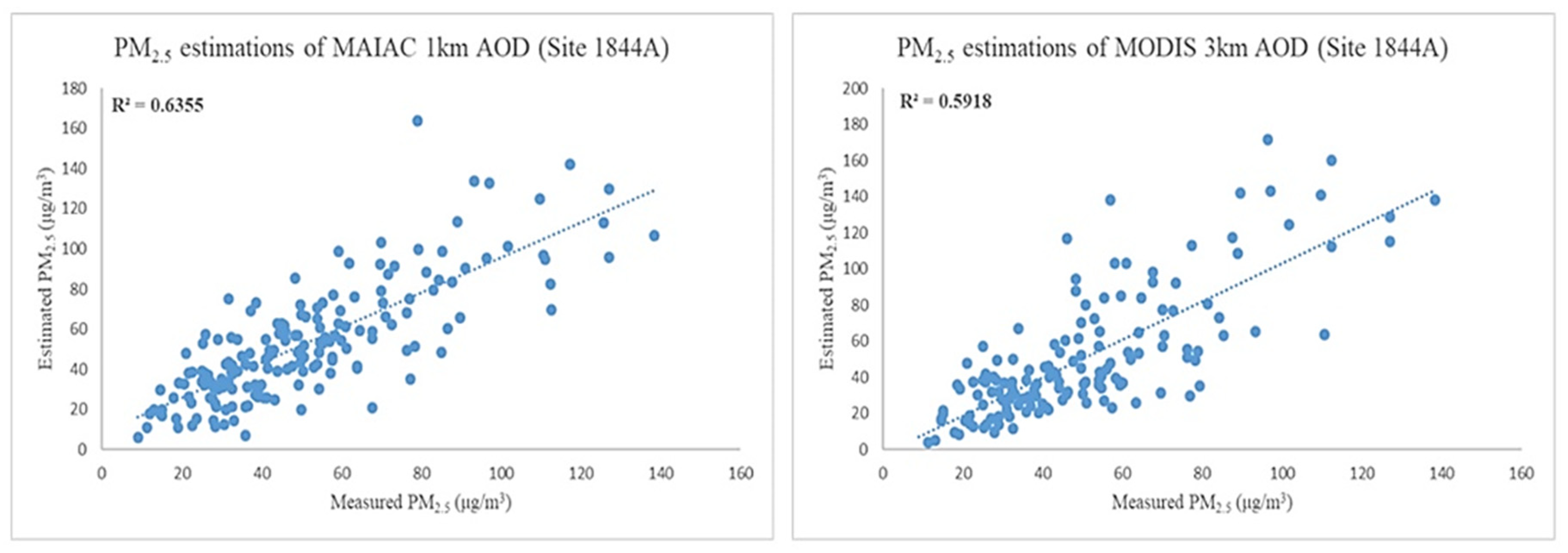
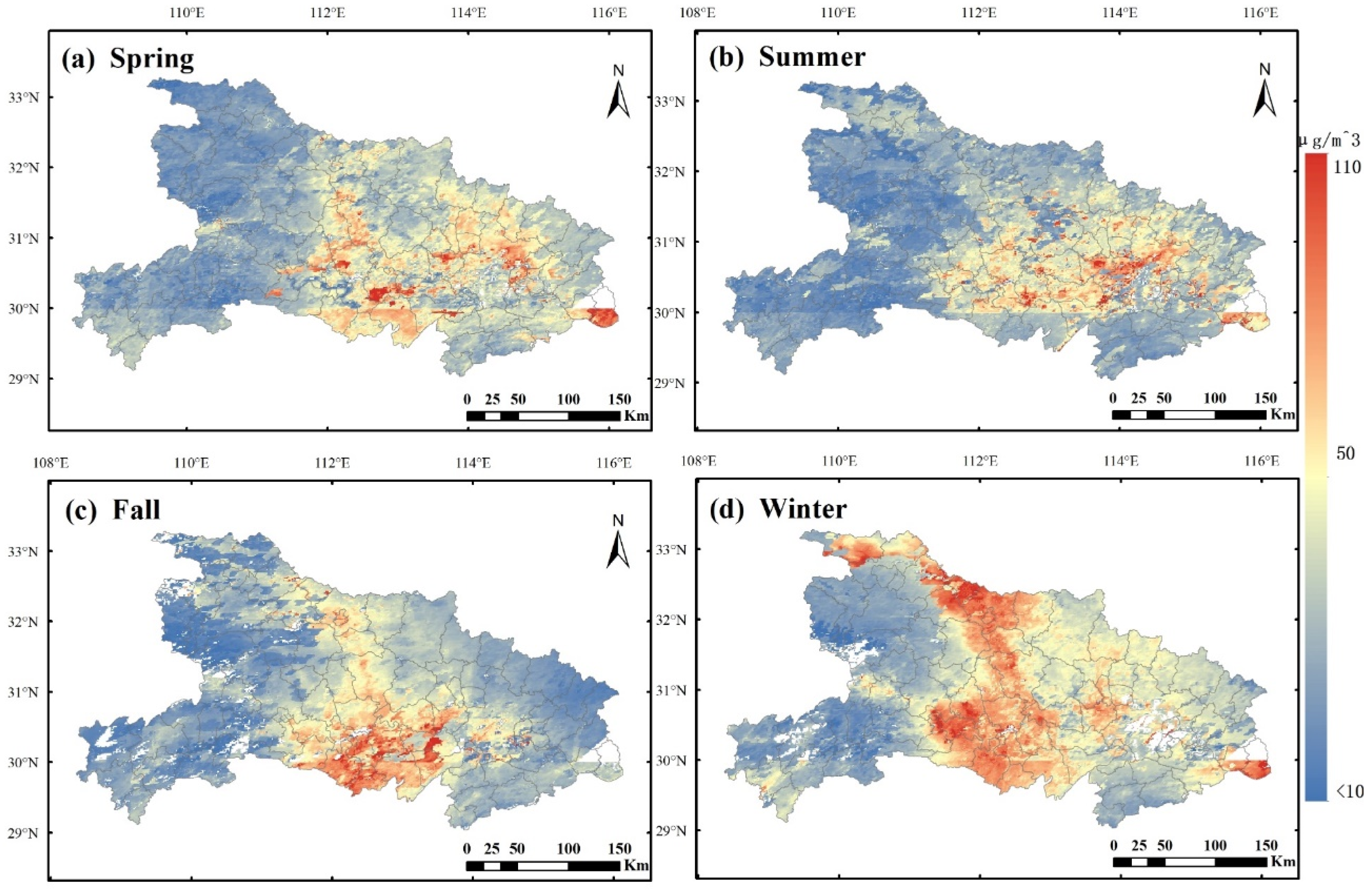
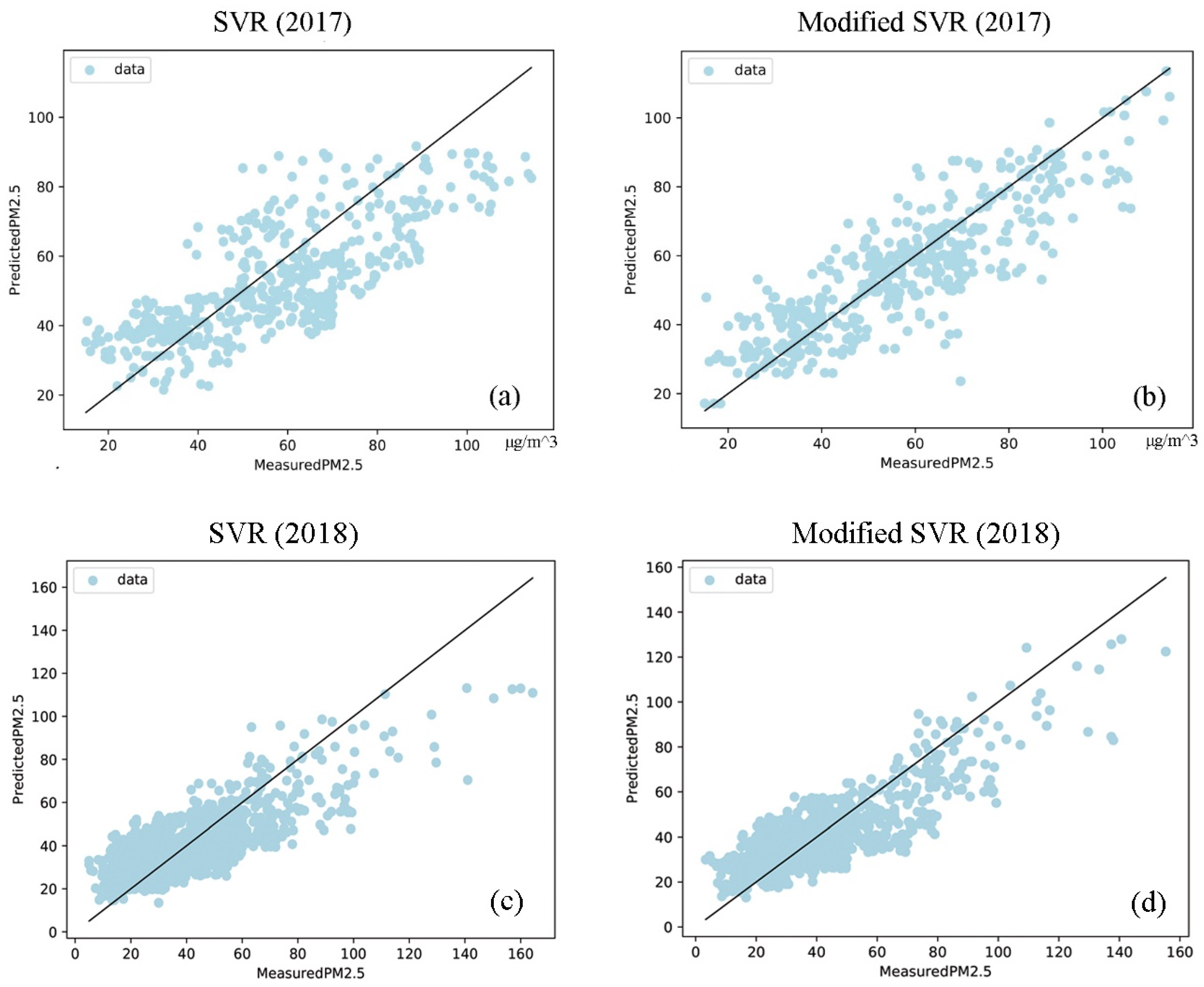
| Variables | Unit | Description | Temporal Period |
|---|---|---|---|
| PM2.5 | μg/m3 | Particulate matter smaller than 2.5 in aerodynamic diameter | Hourly average of 10:00 am to 13:00 pm |
| AOD | Satellite-retrieved Aerosol Optical Depth | Daily data | |
| RH | % | Relative Humidity | Hourly instantaneous data |
| BLH | (m) | Boundary Layer Height | |
| T | °C | 2 m Temperature | |
| Land Cover | Vegetation coverage and construction factors | Remote sensing monitoring data of China’s land use status in 2015 |
| Variables | Mean | Max | Min | Std.Dev. |
|---|---|---|---|---|
| PM2.5 | 66.79 | 344.66 | 4.00 | 43.40 |
| AOD (unit less) | 0.48 | 3.27 | 0.09 | 0.31 |
| Relative humidity (%) | 3.5 | 13.8 | 0.6 | 4.7 |
| BLH (km) | 1.35 | 2.01 | 0.79 | 0.43 |
| 2m temperature (°C) | 14.25 | 33.23 | 4.06 | 5.52 |
| Variables | Mean | Max | Min | Std.Dev. |
|---|---|---|---|---|
| PM2.5 | 52.91 | 328.00 | 2.33 | 34.70 |
| AOD (unit less) | 0.43 | 3.57 | 0.00 | 0.36 |
| Relative humidity (%) | 3.8 | 14.2 | 0.8 | 4.5 |
| BLH (km) | 1.41 | 2.86 | 0.84 | 0.58 |
| 2m temperature (°C) | 14.73 | 36.44 | 2.36 | 6.89 |
| Model | Time Period | R2 | ||
|---|---|---|---|---|
| SVR | Whole year (2017) | 0.60 | 11.16 | 12.58 |
| Spring | 0.61 | 12.14 | 14.53 | |
| Summer | 0.50 | 10.54 | 12.55 | |
| Autumn | 0.56 | 12.63 | 15.31 | |
| Winter | 0.64 | 13.35 | 15.68 | |
| Modified SVR (MSVR) | Whole year (2017) | 0.74 | 9.74 | 10.85 |
| Spring | 0.69 | 10.69 | 13.76 | |
| Summer | 0.53 | 8.33 | 10.36 | |
| Autumn | 0.70 | 10.01 | 14.02 | |
| Winter | 0.82 | 12.35 | 14.71 |
| Model | Time Period | R2 | ||
|---|---|---|---|---|
| SVR | Whole year (2018) | 0.66 | 10.11 | 12.85 |
| Spring | 0.53 | 11.04 | 13.66 | |
| Summer | 0.52 | 9.62 | 11.47 | |
| Autumn | 0.60 | 11.39 | 13.18 | |
| Winter | 0.72 | 12.65 | 14.92 | |
| Modified SVR (MSVR) | Whole year (2018) | 0.78 | 8.92 | 11.32 |
| Spring | 0.61 | 9.58 | 11.89 | |
| Summer | 0.59 | 8.27 | 11.01 | |
| Autumn | 0.76 | 10.17 | 12.22 | |
| Winter | 0.80 | 11.64 | 12.15 |
Publisher’s Note: MDPI stays neutral with regard to jurisdictional claims in published maps and institutional affiliations. |
© 2021 by the authors. Licensee MDPI, Basel, Switzerland. This article is an open access article distributed under the terms and conditions of the Creative Commons Attribution (CC BY) license (http://creativecommons.org/licenses/by/4.0/).
Share and Cite
Chen, N.; Yang, M.; Du, W.; Huang, M. PM2.5 Estimation and Spatial-Temporal Pattern Analysis Based on the Modified Support Vector Regression Model and the 1 km Resolution MAIAC AOD in Hubei, China. ISPRS Int. J. Geo-Inf. 2021, 10, 31. https://doi.org/10.3390/ijgi10010031
Chen N, Yang M, Du W, Huang M. PM2.5 Estimation and Spatial-Temporal Pattern Analysis Based on the Modified Support Vector Regression Model and the 1 km Resolution MAIAC AOD in Hubei, China. ISPRS International Journal of Geo-Information. 2021; 10(1):31. https://doi.org/10.3390/ijgi10010031
Chicago/Turabian StyleChen, Nengcheng, Meijuan Yang, Wenying Du, and Min Huang. 2021. "PM2.5 Estimation and Spatial-Temporal Pattern Analysis Based on the Modified Support Vector Regression Model and the 1 km Resolution MAIAC AOD in Hubei, China" ISPRS International Journal of Geo-Information 10, no. 1: 31. https://doi.org/10.3390/ijgi10010031
APA StyleChen, N., Yang, M., Du, W., & Huang, M. (2021). PM2.5 Estimation and Spatial-Temporal Pattern Analysis Based on the Modified Support Vector Regression Model and the 1 km Resolution MAIAC AOD in Hubei, China. ISPRS International Journal of Geo-Information, 10(1), 31. https://doi.org/10.3390/ijgi10010031







